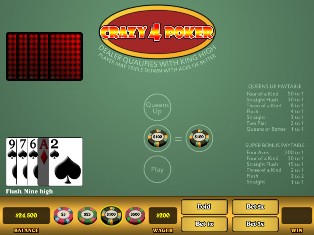On this page
Crazy 4 Poker
Introduction
Crazy 4 Poker is a poker variation invented by Roger Snow and is marketed by Shufflemaster. It has been around since about 2004 and one of the more successful poker-based casino games.
Video Tutorial
Video uses our practice Crazy 4 Poker game.
Rules
- Play starts with the player making equal bets on the Ante and Super Bonus. The player may also bet on the Queens Up side bet at this time.
- Following is the ranking of hands from highest to lowest:
- Four of a kind.
- Straight flush
- Three of a kind
- Flush
- Straight
- Two pair
- Pair
- Four singletons
- All player and dealer get five cards each.
- The player decides to fold or raise by making a Play wager.
- If the player folds he forfeits all bets.
- The Play bet may be up to three times the Ante bet if the player has at least a pair of aces. Otherwise, the Play bet must be exactly equal to the Ante bet.
- Players make their best four-card poker hand, and discard the fifth card.
- After all decisions have been made, the dealer will turn over his cards and select the best four out of five.
- The player's hand shall be compared to the dealer's hand, the higher hand winning.
- For purposes of the Ante bet only, the dealer needs at least a king high to open.
- The Ante bet pays as follows:
- Dealer does not open: Ante pushes.
- Dealer opens and player wins: Ante wins.
- Dealer opens and ties: Ante pushes.
- Dealer opens and wins: Ante loses.
- The Play bet pays as follows:
- Dealer does not open: Play wins.
- Dealer opens and player wins: Play wins.
- Dealer opens and ties player: Play pushes.
- Dealer opens and wins: Play loses.
- The Super Bonus bet pays as follows.*
- Player has straight or higher (beating dealer not required): Super Bonus wins according to pay table below.
- Dealer opens, player has less than straight, and player wins or pushes: Push.
- Dealer opens, player has less than straight, and dealer wins: Loss.
- Dealer does not open: Push.
Super Bonus Pay Table
| Player Hand | Pays |
|---|---|
| Four aces | 200 |
| Four 2-K | 30 |
| Straight flush | 15 |
| Three of a kind | 2 |
| Flush | 1.5 |
| Straight | 1 |
*: In his book The Ultimate Report, James Grosjean notes that the published rules in some casinos and jurisdictions, like Washington state say or imply that the Super Bonus does not automatically push if the dealer doesn't qualify and player has less than a straight. My interpretation of the Washington rules is whether or not the dealer qualifies is irrelevant for the Super Bonus. This matters in situations like the player having a 10-high losing to a dealer jack-high. My analysis is the same either way, as it assumes the player would have folded if he had a hand that could lose to a dealer hand that didn't qualify (queen high or less).However, the Washington rules seemed to be outweighed by published rules by other casinos and gaming authorities that if the dealer doesn't qualify and the player has less than a straight, then the Super Bonus is an automatic push. On Aug. 25, 2023, I switched to the wording in the rules above, for which I give Grosjean credit for the clarification .
Strategy
Optimal strategy would be tedious and complicated memorize. However, the player can get extremely close to it with this simple strategy. Follow the first rule to apply.
- Make large raise when allowed (with pair of aces or higher).
- Make small raise with K-Q-8-4 or higher.
- Fold all other.
The increase in house edge with the KQ84 strategy, compared to optimal, is 0.000089%.
Analysis
The next table shows the return of the Ante bet under optimal player strategy.
Ante Bet
| Event | Pays | Combinations | Probability | Return |
|---|---|---|---|---|
| Win | 1 | 1,415,369,375,148 | 0.355028 | 0.355028 |
| Push | 0 | 473,003,972,892 | 0.118647 | 0.000000 |
| Loss | -1 | 2,098,272,755,400 | 0.526325 | -0.526325 |
| Total | 3,986,646,103,440 | 1.000000 | -0.171298 |
The next table shows the return of the Play bet under optimal player strategy. A win of 0 also includes folding, in which case a raise bet was never made.
Raise Bet
| Win | Combinations | Probability | Return |
|---|---|---|---|
| 3 | 671,609,661,948 | 0.168465 | 0.505394 |
| 1 | 1,215,649,215,684 | 0.304930 | 0.304930 |
| 0 | 938,265,298,824 | 0.235352 | 0.000000 |
| -1 | 1,093,014,959,196 | 0.274169 | -0.274169 |
| -3 | 68,106,967,788 | 0.017084 | -0.051251 |
| Total | 3,986,646,103,440 | 1.000000 | 0.484904 |
The next table shows the return of the Super Bonus bet under optimal player strategy.
Super Bonus Bet
| Event | Pays | Combinations | Probability | Return |
|---|---|---|---|---|
| Four aces | 200 | 73,629,072 | 0.000018 | 0.003694 |
| Four 2-K | 30 | 883,548,864 | 0.000222 | 0.006649 |
| Straight flush | 15 | 3,178,321,608 | 0.000797 | 0.011959 |
| Three of a kind | 2 | 89,974,725,984 | 0.022569 | 0.045138 |
| Flush | 1.5 | 175,813,952,424 | 0.044101 | 0.066151 |
| Straight | 1 | 156,167,261,712 | 0.039173 | 0.039173 |
| Push | 0 | 1,485,273,310,140 | 0.372562 | 0.000000 |
| Loss | -1 | 2,075,281,353,636 | 0.520558 | -0.520558 |
| Total | 3,986,646,103,440 | 1.000000 | -0.347795 |
The next table summarizes the Ante, Play, and Super Bonus bets. The sum shows the player can expect to lose 3.48% for every hand played, compared to the size of his Ante (or Super Bonus) bet. For example, if the player started with $10 on both the Ante and Super Bonus, then he could expect to lose 34.8¢, assuming optimal strategy.
Summary
| Bet | Return |
|---|---|
| Ante | -0.171298 |
| Raise | 0.484904 |
| Super Bonus | -0.347795 |
| Total | -0.034189 |
The next table shows the net overall win between the Ante, Play, and Super Bonus under optimal player strategy.
Net Win
| Win | Combinations | Probability | Return |
|---|---|---|---|
| 204 | 56,580,432 | 0.000014 | 0.002895 |
| 203 | 17,048,640 | 0.000004 | 0.000868 |
| 34 | 764,060,808 | 0.000192 | 0.006516 |
| 33 | 119,340,480 | 0.000030 | 0.000988 |
| 26 | 147,576 | 0.000000 | 0.000001 |
| 19 | 2,708,500,216 | 0.000679 | 0.012908 |
| 18 | 467,451,204 | 0.000117 | 0.002111 |
| 15 | 239,544 | 0.000000 | 0.000001 |
| 11 | 2,130,644 | 0.000001 | 0.000006 |
| 6 | 75,428,689,424 | 0.018920 | 0.113522 |
| 5.5 | 140,729,630,976 | 0.035300 | 0.194151 |
| 5 | 132,528,726,036 | 0.033243 | 0.166216 |
| 4.5 | 26,782,817,436 | 0.006718 | 0.030232 |
| 4 | 240,544,812,516 | 0.060338 | 0.241351 |
| 3 | 51,462,003,780 | 0.012909 | 0.038726 |
| 2 | 859,165,302,444 | 0.215511 | 0.431022 |
| 1.5 | 11,157,384 | 0.000003 | 0.000004 |
| 1 | 356,744,817,336 | 0.089485 | 0.089485 |
| 0 | 842,169,384 | 0.000211 | 0.000000 |
| -2 | 938,364,828,496 | 0.235377 | -0.470754 |
| -2.5 | 8,290,346,628 | 0.002080 | -0.005199 |
| -3 | 1,106,499,736,032 | 0.277552 | -0.832655 |
| -5 | 45,115,566,024 | 0.011317 | -0.056583 |
| Total | 3,986,646,103,440 | 1.000000 | -0.034189 |
The bottom right cell of the table above shows a house edge of 3.42%. This is the ratio of the expected player loss to the Ante bet. One might argue that since the Super Bonus bet is required I define the house edge as the expected loss to the sum of the required starting bets. However, in the interests of consistency with how the term is defined in other games, I choose to base the house edge on the Ante only. So, for every $100 you bet on the Ante you can expect to lose $3.42 between the Ante, Raise, and Super Bonus combined.
The standard deviation is 3.13, based on the Ante bet.
Overall the player has a 18.56% chance of making a big raise, 57.93% for a small raise, and 23.51% for folding, for an average final wager of 3.14 units. Thus, the element of risk of the game (ratio of expected loss to average total bet) is 3.42%/3.14 = 1.09%.
Queens Up
As far as I know, there are four pay tables available for the Queens Up, according to the choice of casino management. Most Las Vegas casinos use pay table 4.
Queens Up Pay Tables
| Player Hand | Pay Table 1 | Pay Table 2 | Pay Table 3 | Pay Table 4 |
|---|---|---|---|---|
| Four of a kind | 50 to 1 | 50 to 1 | 50 to 1 | 50 to 1 |
| Straight flush | 30 to 1 | 40 to 1 | 30 to 1 | 40 to 1 |
| Three of a kind | 9 to 1 | 8 to 1 | 8 to 1 | 7 to 1 |
| Flush | 4 to 1 | 4 to 1 | 4 to 1 | 4 to 1 |
| Straight | 3 to 1 | 3 to 1 | 3 to 1 | 3 to 1 |
| Two pair | 2 to 1 | 2 to 1 | 2 to 1 | 2 to 1 |
| Pair of queens or better | 1 to 1 | 1 to 1 | 1 to 1 | 1 to 1 |
Queens Up — Pay Table 1
| Event | Pays | Combinations | Probability | Return |
|---|---|---|---|---|
| Four of a kind | 50 | 624 | 0.000240 | 0.012005 |
| Straight flush | 30 | 2,072 | 0.000797 | 0.023917 |
| Three of a kind | 9 | 58,656 | 0.022569 | 0.203121 |
| Flush | 4 | 114,616 | 0.044101 | 0.176403 |
| Straight | 3 | 101,808 | 0.039173 | 0.117518 |
| Two pair | 2 | 123,552 | 0.047539 | 0.095078 |
| Pair of Qs to As | 1 | 242,916 | 0.093467 | 0.093467 |
| Loser | -1 | 1,954,716 | 0.752115 | -0.752115 |
| Total | 2,598,960 | 1.000000 | -0.030606 |
Queens Up — Pay Table 2
| Event | Pays | Combinations | Probability | Return |
|---|---|---|---|---|
| Four of a kind | 50 | 624 | 0.000240 | 0.012005 |
| Straight flush | 40 | 2,072 | 0.000797 | 0.031890 |
| Three of a kind | 8 | 58,656 | 0.022569 | 0.180552 |
| Flush | 4 | 114,616 | 0.044101 | 0.176403 |
| Straight | 3 | 101,808 | 0.039173 | 0.117518 |
| Two pair | 2 | 123,552 | 0.047539 | 0.095078 |
| Pair of Qs to As | 1 | 242,916 | 0.093467 | 0.093467 |
| Loser | -1 | 1,954,716 | 0.752115 | -0.752115 |
| Total | 2,598,960 | 1.000000 | -0.045203 |
Queens Up — Pay Table 3
| Event | Pays | Combinations | Probability | Return |
|---|---|---|---|---|
| Four of a kind | 50 | 624 | 0.000240 | 0.012005 |
| Straight flush | 30 | 2,072 | 0.000797 | 0.023917 |
| Three of a kind | 8 | 58,656 | 0.022569 | 0.180552 |
| Flush | 4 | 114,616 | 0.044101 | 0.176403 |
| Straight | 3 | 101,808 | 0.039173 | 0.117518 |
| Two pair | 2 | 123,552 | 0.047539 | 0.095078 |
| Pair of Qs to As | 1 | 242,916 | 0.093467 | 0.093467 |
| Loser | -1 | 1,954,716 | 0.752115 | -0.752115 |
| Total | 2,598,960 | 1.000000 | -0.053175 |
Queens Up — Pay Table 4
| Event | Pays | Combinations | Probability | Return |
|---|---|---|---|---|
| Four of a kind | 50 | 624 | 0.000240 | 0.012005 |
| Straight flush | 40 | 2,072 | 0.000797 | 0.031890 |
| Three of a kind | 7 | 58,656 | 0.022569 | 0.157983 |
| Flush | 4 | 114,616 | 0.044101 | 0.176403 |
| Straight | 3 | 101,808 | 0.039173 | 0.117518 |
| Two pair | 2 | 123,552 | 0.047539 | 0.095078 |
| Pair of Qs to As | 1 | 242,916 | 0.093467 | 0.093467 |
| Loser | -1 | 1,954,716 | 0.752115 | -0.752115 |
| Total | 2,598,960 | 1.000000 | -0.067772 |
6-Card Bonus
Some casinos add on a side bet known as the 6-Card Bonus. This side bet is found on multiple poker-derivative games, so I created a special page for it. For more information, please see my page on the 6-Card Bonus.
Millionaire Progressive
This is a $5 "red light" progressive side bet that pays $1,000,000 for a royal flush in spades, using the player's five cards. For all the rules and analysis, please see my page on the Millionaire Progressive.
Practice Game
Before you play for real money, practice your Crazy 4 Poker game right here.
Internal Links
There is also a similar game called Four Card Poker.
External Links
Shufflemaster's official web site for Crazy 4 Poker.




